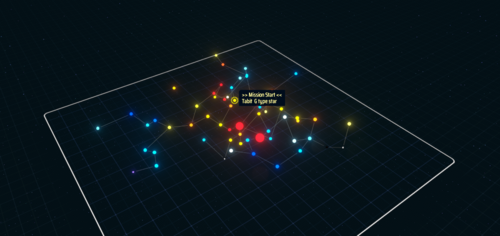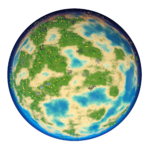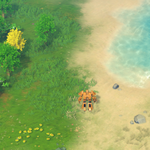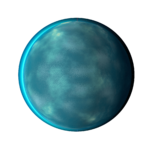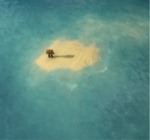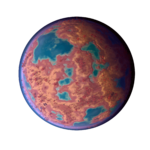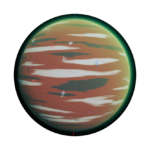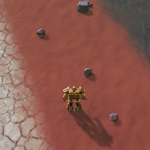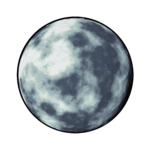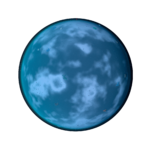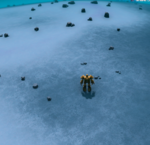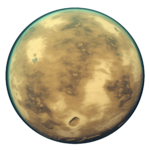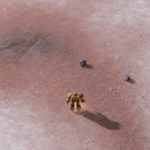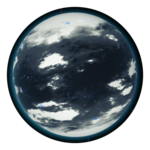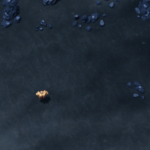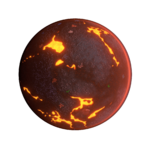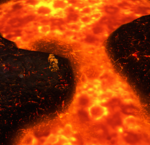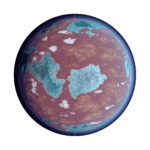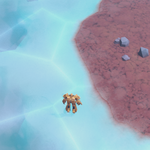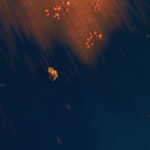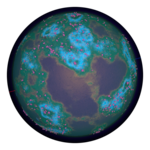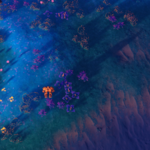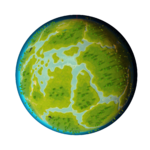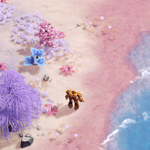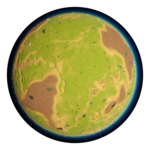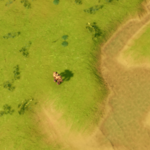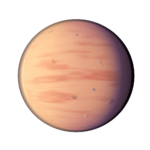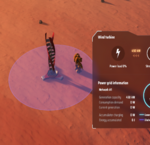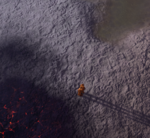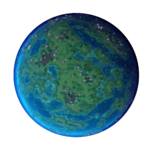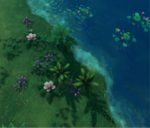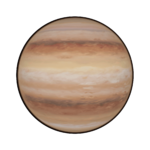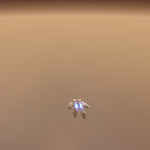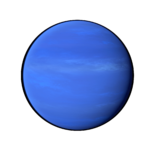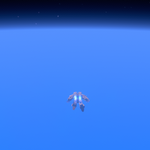(→Types of planets: update planet names) |
(→Types of planets: Maroonfrost did not require foudations to build on the ocean;) |
||
| (One intermediate revision by the same user not shown) | |||
| Line 31: | Line 31: | ||
!Name!!Description!!Statistics!!Image!!Surface view | !Name!!Description!!Statistics!!Image!!Surface view | ||
|- | |- | ||
!Mariterra<ref>Formerly called "Mediterranean"</ref> | !{{anchor|Mariterra|Mariterra}}<ref>Formerly called "Mediterranean"</ref> | ||
|A lush and tropical habitable world covered with oceans. | |A lush and tropical habitable world covered with oceans. | ||
Mariterra planets are abundant with basic resources and oil, but lack advanced resources. | Mariterra planets are abundant with basic resources and oil, but lack advanced resources. | ||
| Line 45: | Line 45: | ||
|[[File:Mediterainean planet view.PNG|150px|center]]||[[File:Mediterranean planet surface.png|150px|center]] | |[[File:Mediterainean planet view.PNG|150px|center]]||[[File:Mediterranean planet surface.png|150px|center]] | ||
|- | |- | ||
!Aquatica<ref>Formerly called "Waterworld"</ref> | !{{anchor|Aquatica|Aquatica}}<ref>Formerly called "Waterworld"</ref> | ||
|A unique habitable world covered almost entirely by a single large ocean. | |A unique habitable world covered almost entirely by a single large ocean. | ||
Constructing any large infrastructure on their surfaces will be resource and time intensive. However, these planets contain huge deposits of [[Crude Oil]] and [[Spiniform_Stalagmite_Crystal|Spiniform Stalagmite Crystals]] that make the efforts worthwhile. Better carry lots of [[Soil Pile|Soil Piles]] and [[Foundation|Foundations]] before visiting! | Constructing any large infrastructure on their surfaces will be resource and time intensive. However, these planets contain huge deposits of [[Crude Oil]] and [[Spiniform_Stalagmite_Crystal|Spiniform Stalagmite Crystals]] that make the efforts worthwhile. Better carry lots of [[Soil Pile|Soil Piles]] and [[Foundation|Foundations]] before visiting! | ||
| Line 58: | Line 58: | ||
|[[File:Ocean planet view.PNG|150px|center]]||[[File:Ocean planet surface.png|150px|center]] | |[[File:Ocean planet view.PNG|150px|center]]||[[File:Ocean planet surface.png|150px|center]] | ||
|- | |- | ||
!Crimsonis<ref>Formerly called "Red stone"</ref> | !{{anchor|Crimsonis|Crimsonis}}<ref>Formerly called "Red stone"</ref> | ||
|A habitable world similar to Mariterra planets, but with red soil and mushrooms growing all across the surface. | |A habitable world similar to Mariterra planets, but with red soil and mushrooms growing all across the surface. | ||
They have similar resources to Mariterra planets, but also spawn other rare organic resources. | They have similar resources to Mariterra planets, but also spawn other rare organic resources. | ||
| Line 70: | Line 70: | ||
|[[File:Red Stone planet view.PNG|150px|center]]||[[File:Red mushroom planet surface.png|150px|center]] | |[[File:Red Stone planet view.PNG|150px|center]]||[[File:Red mushroom planet surface.png|150px|center]] | ||
|- | |- | ||
!Cyclonius<ref>Formerly called "Hurricane Stone Forest"</ref><ref name="0.7.18.6914">Added in the [[Patch Notes/0.7.18.6914|Patch 0.7.18.6914]]</ref> | !{{anchor|Cyclonius|Cyclonius}}<ref>Formerly called "Hurricane Stone Forest"</ref><ref name="0.7.18.6914">Added in the [[Patch Notes/0.7.18.6914|Patch 0.7.18.6914]]</ref> | ||
|A hot, barren world with an active atmosphere. Strong winds eroded the surface and caused its unique terrain. | |A hot, barren world with an active atmosphere. Strong winds eroded the surface and caused its unique terrain. | ||
| Line 79: | Line 79: | ||
*Common resources: [[Silicon Ore|Silicon]], [[Stone]], [[Titanium Ore|Titanium]], [[Iron Ore|Iron]], [[Copper Ore|Copper]], [[Coal]] (few) | *Common resources: [[Silicon Ore|Silicon]], [[Stone]], [[Titanium Ore|Titanium]], [[Iron Ore|Iron]], [[Copper Ore|Copper]], [[Coal]] (few) | ||
*Rare resources: [[Fractal Silicon]], [[Kimberlite Ore]], [[ | *Rare resources: [[Fractal Silicon]], [[Kimberlite Ore]], [[Grating Crystal]] | ||
*Ocean: None | *Ocean: None | ||
*Construction area: ~100% | *Construction area: ~100% | ||
| Line 85: | Line 85: | ||
|[[File:Hurricane stone forest planet view.png|150px|center]]||[[File:Hurricane stone forest planet surface.png|150px|center]] | |[[File:Hurricane stone forest planet view.png|150px|center]]||[[File:Hurricane stone forest planet surface.png|150px|center]] | ||
|- | |- | ||
!Desolus<ref>Formerly called "Barren desert"</ref> | !{{anchor|Desolus|Desolus}}<ref>Formerly called "Barren desert"</ref> | ||
| A barren world with no atmosphere, its surface covered with craters, lifeless dirt, and rock. These planets are similar to the moon that orbits Earth. | | A barren world with no atmosphere, its surface covered with craters, lifeless dirt, and rock. These planets are similar to the moon that orbits Earth. | ||
Since there's no atmosphere, [[Wind_Turbine|Wind Turbines]] are useless. There are no oceans either, so these planets have large amounts of construction area, and can as such be a decent source of [[Soil_Pile|Soil Piles]]. | Since there's no atmosphere, [[Wind_Turbine|Wind Turbines]] are useless. There are no oceans either, so these planets have large amounts of construction area, and can as such be a decent source of [[Soil_Pile|Soil Piles]]. | ||
| Line 91: | Line 91: | ||
*Common resources: [[Stone]], [[Titanium Ore|Titanium]], [[Silicon Ore|Silicon]], [[Iron Ore|Iron]], [[Copper Ore|Copper]] | *Common resources: [[Stone]], [[Titanium Ore|Titanium]], [[Silicon Ore|Silicon]], [[Iron Ore|Iron]], [[Copper Ore|Copper]] | ||
*Rare resources: [[Fire Ice]], [[Kimberlite Ore]], [[ | *Rare resources: [[Fire Ice]], [[Kimberlite Ore]], [[Grating Crystal]] (few) | ||
*Ocean: None | *Ocean: None | ||
*Construction area: ~100% | *Construction area: ~100% | ||
| Line 97: | Line 97: | ||
|[[File:Barren Desert planet view.PNG|150px|center]]||[[File:Barren planet surface.png|150px|center]] | |[[File:Barren Desert planet view.PNG|150px|center]]||[[File:Barren planet surface.png|150px|center]] | ||
|- | |- | ||
!Geloterra<ref>Formerly called "Ashen gelisol"</ref> | !{{anchor|Geloterra|Geloterra}}<ref>Formerly called "Ashen gelisol"</ref> | ||
|A frozen world covered with rock and soil. | |A frozen world covered with rock and soil. | ||
Geloterra planets generally contain a large number of various resources, but their thin atmosphere and lack of fuel can easily lead to power shortages. | Geloterra planets generally contain a large number of various resources, but their thin atmosphere and lack of fuel can easily lead to power shortages. | ||
| Line 109: | Line 109: | ||
|[[File:Ashen Gelisol planet view.PNG|150px|center]]||[[File:Ashen gelisol planet surface.png|150px|center]] | |[[File:Ashen Gelisol planet view.PNG|150px|center]]||[[File:Ashen gelisol planet surface.png|150px|center]] | ||
|- | |- | ||
!Glacieon<ref>Formerly called "Ice field gelisol"</ref> | !{{anchor|Glacieon|Glacieon}}<ref>Formerly called "Ice field gelisol"</ref> | ||
|A frozen planet covered in ice that may have pockets of water scattered around the surface. These planets are similar to Jupiter's moon Europa. | |A frozen planet covered in ice that may have pockets of water scattered around the surface. These planets are similar to Jupiter's moon Europa. | ||
Large veins of [[Fire Ice]] can be found on these planets. Since they're usually far away from their star and have weak winds, they're terrible sources for renewable energy. Use of [[Thermal_Power_Station|Thermal Power Stations]] is recommended. | Large veins of [[Fire Ice]] can be found on these planets. Since they're usually far away from their star and have weak winds, they're terrible sources for renewable energy. Use of [[Thermal_Power_Station|Thermal Power Stations]] is recommended. | ||
| Line 115: | Line 115: | ||
*Common resources: [[Titanium Ore|Titanium]], [[Silicon Ore|Silicon]], [[Iron Ore|Iron]], [[Stone]], [[Copper Ore|Copper]] (few), [[Coal]] (few) | *Common resources: [[Titanium Ore|Titanium]], [[Silicon Ore|Silicon]], [[Iron Ore|Iron]], [[Stone]], [[Copper Ore|Copper]] (few), [[Coal]] (few) | ||
*Rare resources: [[Fire Ice]] {{glow|(guaranteed)}}, [[Fractal Silicon]], [[ | *Rare resources: [[Fire Ice]] {{glow|(guaranteed)}}, [[Fractal Silicon]], [[Grating Crystal]] | ||
*Ocean: [[Water]] | *Ocean: [[Water]] | ||
*Construction area: ~98% | *Construction area: ~98% | ||
| Line 121: | Line 121: | ||
|[[File:Ice Field Gelisol planet view.PNG|150px|center]]||[[File:Ice planet surface.png|150px|center|]] | |[[File:Ice Field Gelisol planet view.PNG|150px|center]]||[[File:Ice planet surface.png|150px|center|]] | ||
|- | |- | ||
!Gobi | !{{anchor|Gobi|Gobi}} | ||
|A dry, barren world covered with deserts and possessing a thin atmosphere. | |A dry, barren world covered with deserts and possessing a thin atmosphere. | ||
Gobi planets contain mountains, so they're a great source for [[Soil_Pile|soil piles]]. The rest of their terrain is naturally flat, making them ideal places for large-scale construction. | Gobi planets contain mountains, so they're a great source for [[Soil_Pile|soil piles]]. The rest of their terrain is naturally flat, making them ideal places for large-scale construction. | ||
| Line 129: | Line 129: | ||
*Common resources: [[Copper Ore|Copper]], [[Silicon Ore|Silicon]], [[Coal]], [[Stone]], [[Iron Ore|Iron]] | *Common resources: [[Copper Ore|Copper]], [[Silicon Ore|Silicon]], [[Coal]], [[Stone]], [[Iron Ore|Iron]] | ||
*Rare resources: [[Fractal Silicon]], [[Kimberlite Ore]], [[ | *Rare resources: [[Fractal Silicon]], [[Kimberlite Ore]], [[Grating Crystal]] (few) | ||
*Ocean: None | *Ocean: None | ||
*Construction area: ~98% | *Construction area: ~98% | ||
| Line 135: | Line 135: | ||
|[[File:Gobi planet view.PNG|150px|center]]||[[File:Gobi desert planet surface.png|150px|center]] | |[[File:Gobi planet view.PNG|150px|center]]||[[File:Gobi desert planet surface.png|150px|center]] | ||
|- | |- | ||
!Halitum<ref>Formerly called "Rocky Salt Lake"</ref><ref name="0.7.18.6914" /> | !{{anchor|Halitum|Halitum}}<ref>Formerly called "Rocky Salt Lake"</ref><ref name="0.7.18.6914" /> | ||
|A barren world covered with vast salt flats and some normal soil. | |A barren world covered with vast salt flats and some normal soil. | ||
| Line 142: | Line 142: | ||
*Common resources: [[Silicon Ore|Silicon]], [[Iron Ore|Iron]], [[Copper Ore|Copper]], [[Stone]], [[Titanium Ore|Titanium]], [[Coal]] (few) | *Common resources: [[Silicon Ore|Silicon]], [[Iron Ore|Iron]], [[Copper Ore|Copper]], [[Stone]], [[Titanium Ore|Titanium]], [[Coal]] (few) | ||
*Rare resources: [[Kimberlite Ore]], [[ | *Rare resources: [[Kimberlite Ore]], [[Grating Crystal]] (few) | ||
*Ocean: None | *Ocean: None | ||
*Construction area: ~100% | *Construction area: ~100% | ||
| Line 148: | Line 148: | ||
|[[File:Rocky salt lake planet view.png|150px|center]]||[[File:Rocky salt lake planet surface.png|150px|center]] | |[[File:Rocky salt lake planet view.png|150px|center]]||[[File:Rocky salt lake planet surface.png|150px|center]] | ||
|- | |- | ||
!Icefrostia<ref>Formerly called "Frozen tundra"</ref><ref name="0.9.26.12891" /> | !{{anchor|Icefrostia|Icefrostia}}<ref>Formerly called "Frozen tundra"</ref><ref name="0.9.26.12891" /> | ||
|A frozen world covered by tundra and snow, and possessing an active atmosphere. | |A frozen world covered by tundra and snow, and possessing an active atmosphere. | ||
| Line 155: | Line 155: | ||
*Common resources: [[Silicon Ore|Silicon]], [[Stone]], [[Titanium Ore|Titanium]], [[Iron Ore|Iron]], [[Copper Ore|Copper]], [[Coal]] (few) | *Common resources: [[Silicon Ore|Silicon]], [[Stone]], [[Titanium Ore|Titanium]], [[Iron Ore|Iron]], [[Copper Ore|Copper]], [[Coal]] (few) | ||
*Rare resources: [[Fire Ice]] {{glow|(guaranteed)}}, [[Kimberlite Ore]] {{glow|(guaranteed)}}, [[ | *Rare resources: [[Fire Ice]] {{glow|(guaranteed)}}, [[Kimberlite Ore]] {{glow|(guaranteed)}}, [[Grating Crystal]] (few) | ||
*Ocean: None | *Ocean: None | ||
*Construction area: ~100% | *Construction area: ~100% | ||
| Line 162: | Line 162: | ||
|[[File:Frozen tundra planet surface.png|center|150x150px|alt=]] | |[[File:Frozen tundra planet surface.png|center|150x150px|alt=]] | ||
|- | |- | ||
!Lava | !{{anchor|Lava|Lava}} | ||
|A hot world covered with lakes of molten lava. | |A hot world covered with lakes of molten lava. | ||
Lava planets usually contain vast amounts of metal ores, and these planets can use [[Geothermal Power Station|Geothermal Power Stations]] to freely harvest energy. Good for mining sites. | Lava planets usually contain vast amounts of metal ores, and these planets can use [[Geothermal Power Station|Geothermal Power Stations]] to freely harvest energy. Good for mining sites. | ||
| Line 168: | Line 168: | ||
*Common resources: [[Titanium Ore|Titanium]], [[Iron Ore|Iron]], [[Copper Ore|Copper]], [[Stone]], [[Silicon Ore|Silicon]], [[Coal]] (few) | *Common resources: [[Titanium Ore|Titanium]], [[Iron Ore|Iron]], [[Copper Ore|Copper]], [[Stone]], [[Silicon Ore|Silicon]], [[Coal]] (few) | ||
*Rare resources: [[Fractal Silicon]], [[Kimberlite Ore]], [[ | *Rare resources: [[Fractal Silicon]], [[Kimberlite Ore]], [[Grating Crystal]] | ||
*Ocean: Lava | *Ocean: Lava | ||
*Construction area: ~85% | *Construction area: ~85% | ||
| Line 174: | Line 174: | ||
|[[File:Lava planet view.PNG|150px|center]]||[[File:Lava planet surface.png|150px|center]] | |[[File:Lava planet view.PNG|150px|center]]||[[File:Lava planet surface.png|150px|center]] | ||
|- | |- | ||
!Maroonfrost<ref>Formerly called "Scarlet Ice Lake"</ref><ref name="0.7.18.6914" /> | !{{anchor|Maroonfrost|Maroonfrost}}<ref>Formerly called "Scarlet Ice Lake"</ref><ref name="0.7.18.6914" /> | ||
|A frozen world covered by scarlet soil and large swathes of frozen ocean. | |A frozen world covered by scarlet soil and large swathes of frozen ocean. | ||
Maroonfrosts are barren, frozen planets with large deposits of [[Copper Ore]] and [[Titanium Ore]], but not much else. | Maroonfrosts are barren, frozen planets with large deposits of [[Copper Ore]] and [[Titanium Ore]], but not much else. | ||
Notably, [[Icarus]] can walk and place buildings directly on the planet's frozen oceans | Notably, [[Icarus]] can walk and place buildings directly on the planet's frozen oceans. | ||
| | | | ||
*Common resources: [[Titanium Ore|Titanium]], [[Copper Ore|Copper]], [[Iron Ore|Iron]], [[Stone]], [[Silicon Ore|Silicon]] (few), [[Coal]] (few) | *Common resources: [[Titanium Ore|Titanium]], [[Copper Ore|Copper]], [[Iron Ore|Iron]], [[Stone]], [[Silicon Ore|Silicon]] (few), [[Coal]] (few) | ||
*Rare resources: [[Fire Ice]] {{glow|(guaranteed)}}, [[ | *Rare resources: [[Fire Ice]] {{glow|(guaranteed)}}, [[Grating Crystal]], [[Kimberlite Ore]] (few) | ||
*Ocean: Ice | *Ocean: Ice | ||
*Construction area: ~70% | *Construction area: ~70% | ||
| Line 189: | Line 189: | ||
|[[File:Scarlet ice lake planet view.png|150px|center]]||[[File:Scarlet ice lake planet surface.png|150px|center]] | |[[File:Scarlet ice lake planet view.png|150px|center]]||[[File:Scarlet ice lake planet surface.png|150px|center]] | ||
|- | |- | ||
!Onyxtopia<ref>Formerly called "Crystal desert"</ref><ref name="0.9.26.12891">Added in the [[Patch Notes/0.9.26.12891|Patch 0.9.26.12891]]</ref> | !{{anchor|Onyxtopia|Onyxtopia}}<ref>Formerly called "Crystal desert"</ref><ref name="0.9.26.12891">Added in the [[Patch Notes/0.9.26.12891|Patch 0.9.26.12891]]</ref> | ||
|A barren world covered with deserts of various crystalized matter, and possessing an active atmosphere. | |A barren world covered with deserts of various crystalized matter, and possessing an active atmosphere. | ||
Onyxtopia planets contain deposits of various crystal resources, especially [[ | Onyxtopia planets contain deposits of various crystal resources, especially [[Grating Crystal]], which always appears in vast numbers. Strong winds provide a great source of energy, making these planets ideal for building mining sites. | ||
| | | | ||
*Common resources: [[Iron Ore|Iron]], [[Titanium Ore|Titanium]], [[Copper Ore|Copper]] (few), [[Coal]] (few) | *Common resources: [[Iron Ore|Iron]], [[Titanium Ore|Titanium]], [[Copper Ore|Copper]] (few), [[Coal]] (few) | ||
*Rare resources: [[ | *Rare resources: [[Grating Crystal]] {{glow|(guaranteed)}}, [[Organic Crystal]] (few) | ||
*Ocean: None | *Ocean: None | ||
*Construction area: ~98% | *Construction area: ~98% | ||
| Line 203: | Line 203: | ||
|[[File:Crystal desert planet surface.png|center|150x150px|alt=]] | |[[File:Crystal desert planet surface.png|center|150x150px|alt=]] | ||
|- | |- | ||
!Pandora swamp<ref name="0.9.26.12891" /> | !{{anchor|Pandora swamp|Pandora swamp}}<ref name="0.9.26.12891" /> | ||
|A habitable world covered in bizarre plants, without any notable bodies of water. | |A habitable world covered in bizarre plants, without any notable bodies of water. | ||
| Line 217: | Line 217: | ||
|[[File:Pandora swamp planet surface.png|center|150x150px|alt=]] | |[[File:Pandora swamp planet surface.png|center|150x150px|alt=]] | ||
|- | |- | ||
!Prairirea<ref>Formerly called "Prairie"</ref> | !{{anchor|Prairirea|Prairirea}}<ref>Formerly called "Prairie"</ref> | ||
|A habitable world similar to Mariterra planets, with fewer bodies of water and more grasslands. | |A habitable world similar to Mariterra planets, with fewer bodies of water and more grasslands. | ||
Prairies have rich deposits of organic resources and balanced mineral deposits. However, [[Titanium Ore]] is quite rare on Prairies. | Prairies have rich deposits of organic resources and balanced mineral deposits. However, [[Titanium Ore]] is quite rare on Prairies. | ||
| Line 229: | Line 229: | ||
|[[File:Prairie planet view.PNG|150px|center]]||[[File:Prairie planet surface.png|150px|center]] | |[[File:Prairie planet view.PNG|150px|center]]||[[File:Prairie planet surface.png|150px|center]] | ||
|- | |- | ||
!Sakura Ocean<ref name="0.7.18.6914" /> | !{{anchor|Sakura Ocean|Sakura Ocean}}<ref name="0.7.18.6914" /> | ||
|A colorful habitable world covered with oceans and exotic plants that contain [[Sulfuric Acid]] as sap. | |A colorful habitable world covered with oceans and exotic plants that contain [[Sulfuric Acid]] as sap. | ||
Sakura oceans have similar resources to Oceanic Jungles, rich with organic resources such as [[Crude Oil]] and [[Coal]]. | Sakura oceans have similar resources to Oceanic Jungles, rich with organic resources such as [[Crude Oil]] and [[Coal]]. | ||
| Line 241: | Line 241: | ||
|[[File:Sakura ocean planet view.png|150px|center]]||[[File:Sakura ocean planet surface.png|150px|center]] | |[[File:Sakura ocean planet view.png|150px|center]]||[[File:Sakura ocean planet surface.png|150px|center]] | ||
|- | |- | ||
!Savanna<ref name="0.9.26.12891" /> | !{{anchor|Savanna|Savanna}}<ref name="0.9.26.12891" /> | ||
|A habitable world covered by great plains. Only a handful of bodies of water exist. | |A habitable world covered by great plains. Only a handful of bodies of water exist. | ||
| Line 255: | Line 255: | ||
|[[File:Savanna planet surface.png|center|150x150px|alt=]] | |[[File:Savanna planet surface.png|center|150x150px|alt=]] | ||
|- | |- | ||
!Scorchedia<ref>Formerly called "Arid desert"</ref> | !{{anchor|Scorchedia|Scorchedia}}<ref>Formerly called "Arid desert"</ref> | ||
| A dry, barren world covered with vast deserts. | | A dry, barren world covered with vast deserts. | ||
Scorchedia planets generally contain unbalanced deposits, good for mining certain resources. | Scorchedia planets generally contain unbalanced deposits, good for mining certain resources. | ||
| Line 269: | Line 269: | ||
|[[File:Arid planet view.PNG|150px|center]]||[[File:Arid desert planet surface.png|150px|center]] | |[[File:Arid planet view.PNG|150px|center]]||[[File:Arid desert planet surface.png|150px|center]] | ||
|- | |- | ||
!Sulfuria<ref>Formerly called "Volcanic Ash"</ref> | !{{anchor|Sulfuria|Sulfuria}}<ref>Formerly called "Volcanic Ash"</ref> | ||
|A hot world covered with volcanic ash and pools of [[Sulfuric Acid]]. | |A hot world covered with volcanic ash and pools of [[Sulfuric Acid]]. | ||
Sulfuria planets have no rare resource deposits, but their oceans of Sulfuric Acid can greatly simplify the player's production line. | Sulfuria planets have no rare resource deposits, but their oceans of Sulfuric Acid can greatly simplify the player's production line. | ||
| Line 281: | Line 281: | ||
|[[File:Volcanic Ash planet view.PNG|150px|center]]||[[File:Volcanic ash planet surface.png|150px|center]] | |[[File:Volcanic Ash planet view.PNG|150px|center]]||[[File:Volcanic ash planet surface.png|150px|center]] | ||
|- | |- | ||
!Tropicana<ref>Formerly called "Oceanic jungle"</ref> | !{{anchor|Tropicana|Tropicana}}<ref>Formerly called "Oceanic jungle"</ref> | ||
|A habitable world that covered with vast tropical jungles and huge bodies of water. | |A habitable world that covered with vast tropical jungles and huge bodies of water. | ||
Tropicana planets are filled with organic beings, so they have rich deposits of rare organic resources such as [[Crude Oil]]. However, the amount of water covering their surfaces makes them better suited for mining than manufacturing, unless the player has enough [[Soil Pile|Soil Piles]]. | Tropicana planets are filled with organic beings, so they have rich deposits of rare organic resources such as [[Crude Oil]]. However, the amount of water covering their surfaces makes them better suited for mining than manufacturing, unless the player has enough [[Soil Pile|Soil Piles]]. | ||
| Line 293: | Line 293: | ||
|[[File:Oceanic Jungle planet view.PNG|150px|center]]||[[File:Jungle planet surface.png|150px|center]] | |[[File:Oceanic Jungle planet view.PNG|150px|center]]||[[File:Jungle planet surface.png|150px|center]] | ||
|- | |- | ||
!Gas Giant | !{{anchor|Gas Giant|Gas Giant}} | ||
|[[Gas Giant]]s are commonly found around the universe, and are a good source of [[Deuterium]] and [[Hydrogen]] by using [[Orbital Collector]]s. | |[[Gas Giant]]s are commonly found around the universe, and are a good source of [[Deuterium]] and [[Hydrogen]] by using [[Orbital Collector]]s. | ||
Notably, there are 3 different types of Gas Giants: red, brown, and teal. The teal Gas Giants produce more Deuterium than the others. | Notably, there are 3 different types of Gas Giants: red, brown, and teal. The teal Gas Giants produce more Deuterium than the others. | ||
| Line 299: | Line 299: | ||
|[[File:Gas Giant planet view.PNG|150px|center]]||[[File:Gas giant planet surface.png|150px|center]] | |[[File:Gas Giant planet view.PNG|150px|center]]||[[File:Gas giant planet surface.png|150px|center]] | ||
|- | |- | ||
!Ice Giant | !{{anchor|Ice Giant|Ice Giant}} | ||
|[[Ice Giant]]s are less commonly found around the universe, but are a good source of [[Fire Ice]] and [[Hydrogen]] by using [[Orbital Collector]]s. | |[[Ice Giant]]s are less commonly found around the universe, but are a good source of [[Fire Ice]] and [[Hydrogen]] by using [[Orbital Collector]]s. | ||
| | | | ||
| Line 354: | Line 354: | ||
|'''<big>White Dwarf<big>'''||[[File:White dwarf.png|150px|White dwarf]]|| A stellar remnant left over after the death of a star that was not massive enough to form a neutron star or black hole, composed of electron-degenerate matter. Low luminosity makes them poor sites for construction of [[Dyson Sphere|Dyson sphere]]s. [[Dyson Sphere#The Dyson Swarm|Dyson swarm]]s may still be of some use, due to their considerably lower resource requirements. | |'''<big>White Dwarf<big>'''||[[File:White dwarf.png|150px|White dwarf]]|| A stellar remnant left over after the death of a star that was not massive enough to form a neutron star or black hole, composed of electron-degenerate matter. Low luminosity makes them poor sites for construction of [[Dyson Sphere|Dyson sphere]]s. [[Dyson Sphere#The Dyson Swarm|Dyson swarm]]s may still be of some use, due to their considerably lower resource requirements. | ||
Planets orbiting White Dwarves are guaranteed to have veins of [[Fractal Silicon]], [[Kimberlite Ore]], and [[ | Planets orbiting White Dwarves are guaranteed to have veins of [[Fractal Silicon]], [[Kimberlite Ore]], and [[Grating Crystal]]. | ||
|- | |- | ||
|'''<big>Neutron Star<big>'''||[[File:Neutron star.png|150px|Neutron star]]||A stellar remnant following a supernova, composed of neutrons with a shell of electron-degenerate matter. Low luminosity makes them poor sites for construction of [[Dyson Sphere|Dyson sphere]]s. [[Dyson Sphere#The Dyson Swarm|Dyson swarm]]s may still be of some use with their much lower resource requirements. | |'''<big>Neutron Star<big>'''||[[File:Neutron star.png|150px|Neutron star]]||A stellar remnant following a supernova, composed of neutrons with a shell of electron-degenerate matter. Low luminosity makes them poor sites for construction of [[Dyson Sphere|Dyson sphere]]s. [[Dyson Sphere#The Dyson Swarm|Dyson swarm]]s may still be of some use with their much lower resource requirements. | ||
| Line 388: | Line 388: | ||
|{{RecipeItem|ItemName=Unipolar Magnet|ItemCount=}}|| Only found on planets (Frozen Tundra and Ice Field Gelisol planets) orbiting Neutron Stars or Black Holes. | |{{RecipeItem|ItemName=Unipolar Magnet|ItemCount=}}|| Only found on planets (Frozen Tundra and Ice Field Gelisol planets) orbiting Neutron Stars or Black Holes. | ||
|- | |- | ||
|{{RecipeItem|ItemName= | |{{RecipeItem|ItemName=Grating Crystal|ItemCount=}}||Commonly found on Crystal Desert planets. Also occurs on Frozen Tundra, Hurricane Stone Forest, Scarlet Ice Lake and Ice Field Gelisol planets and rarely on Barren Desert, Lava, Rocky Salt Lake, Gobi and Ashen Gelisol planets. Guaranteed to spawn on planets orbiting White Dwarves. | ||
|- | |- | ||
|{{RecipeItem|ItemName=Deuterium|ItemCount=}}||Only found on [[Gas Giant]]s. | |{{RecipeItem|ItemName=Deuterium|ItemCount=}}||Only found on [[Gas Giant]]s. | ||
Latest revision as of 00:17, 9 January 2024
Summary
There are many types of stars and planets, each with their own advantages and disadvantages in terms of gameplay value.
When picking a star to construct a Dyson sphere around, it's highly recommended to do it around a star with the highest luminosity (L☉) as possible, as many stars can have more than double (~2 L☉) if not triple (~3 L☉) the energy output than the starter system's star (~1 L☉). This makes the process much less time-consuming and considerably more effective than even constructing multiple Dyson sphere around lower-luminosity stars.
Some rare veins and ores can only be found on certain types of planets, and are impossible to find anywhere else.
Types of planets
Planets can be split into several categories. Each has their own rule of spawning when star system is generated.
- Habitable: Planets that have enough liquid water to sustain the existence of life. These can be found in their star's habitable zone. A typical habitable planet has abundant fossil resources such as Coal and Crude Oil.
- Hot: Planets with very high temperature and exotic oceans which contain various fluids. These can be found orbiting close to their star. A typical hot planet has abundant metallic resources such as Iron Ore and Titanium Ore.
- Frozen: Planets with very low temperature and frozen-over oceans of ice. These can be found orbiting far from their star, near the edge of their system. A typical frozen planet has abundant crystalline resources such as Fire Ice.
- Barren: Planets devoid of liquids. These may spawn anywhere in a system. Most barren worlds have abundant non-metallic resources such as Stone, Silicon Ore, and Soil Piles.
- Giant: Huge, gaseous planets without any solid landmass. Icarus cannot land on these planets, but can gather resources from low orbit.
Each planet type has several attributes:
- Common resources: The types of common resources that are sure to spawn.
- Rare resources: The type(s) of rare resources that MAY spawn.
- Ocean: Whether or not the planet has an ocean, and what the ocean is composed of.
- Construction area: The expected percentage of landmass that can be utilized for construction if no Foundation is used.
- Wind energy ratio: The expected effectiveness of Wind Turbines. Zero wind energy ratio means that no atmosphere exists.
- Solar energy ratio: The expected effectiveness of Solar Panels. This largely depends on the planet's distance from its star and the star's type.
| Name | Description | Statistics | Image | Surface view |
|---|---|---|---|---|
| Mariterra[1] | A lush and tropical habitable world covered with oceans.
Mariterra planets are abundant with basic resources and oil, but lack advanced resources. Only one of these planets exists in each cluster, and it is the player's starting planet. |
|||
| Aquatica[2] | A unique habitable world covered almost entirely by a single large ocean.
Constructing any large infrastructure on their surfaces will be resource and time intensive. However, these planets contain huge deposits of Crude Oil and Spiniform Stalagmite Crystals that make the efforts worthwhile. Better carry lots of Soil Piles and Foundations before visiting! |
|
||
| Crimsonis[3] | A habitable world similar to Mariterra planets, but with red soil and mushrooms growing all across the surface.
They have similar resources to Mariterra planets, but also spawn other rare organic resources. |
|
||
| Cyclonius[4][5] | A hot, barren world with an active atmosphere. Strong winds eroded the surface and caused its unique terrain.
These planets possess great wind and solar energy ratios and contain many different deposits, perfect for mining sites. Due to their extreme atmosphere, these planets contain vast amounts of Soil Piles. |
|
||
| Desolus[6] | A barren world with no atmosphere, its surface covered with craters, lifeless dirt, and rock. These planets are similar to the moon that orbits Earth.
Since there's no atmosphere, Wind Turbines are useless. There are no oceans either, so these planets have large amounts of construction area, and can as such be a decent source of Soil Piles. |
|
||
| Geloterra[7] | A frozen world covered with rock and soil.
Geloterra planets generally contain a large number of various resources, but their thin atmosphere and lack of fuel can easily lead to power shortages. |
|||
| Glacieon[8] | A frozen planet covered in ice that may have pockets of water scattered around the surface. These planets are similar to Jupiter's moon Europa.
Large veins of Fire Ice can be found on these planets. Since they're usually far away from their star and have weak winds, they're terrible sources for renewable energy. Use of Thermal Power Stations is recommended. |
|
||
| Gobi | A dry, barren world covered with deserts and possessing a thin atmosphere.
Gobi planets contain mountains, so they're a great source for soil piles. The rest of their terrain is naturally flat, making them ideal places for large-scale construction. These planets contain large numbers of deposits, but their lack of naturally-occurring Titanium Ore makes it hard to handle advanced production without importing Titanium. |
|
||
| Halitum[9][5] | A barren world covered with vast salt flats and some normal soil.
These planets contain various minerals, have rich deposits of Silicon Ore, and have naturally flat terrain, making them perfect for mining and manufacturing alike. |
|
||
| Icefrostia[10][11] | A frozen world covered by tundra and snow, and possessing an active atmosphere.
These planets consist of black soil and white snow and contain large numbers of common and rare ore deposits. Naturally flat terrain also allows the construction of large manufacturing plants. |
|
||
| Lava | A hot world covered with lakes of molten lava.
Lava planets usually contain vast amounts of metal ores, and these planets can use Geothermal Power Stations to freely harvest energy. Good for mining sites. |
|
||
| Maroonfrost[12][5] | A frozen world covered by scarlet soil and large swathes of frozen ocean.
Maroonfrosts are barren, frozen planets with large deposits of Copper Ore and Titanium Ore, but not much else. Notably, Icarus can walk and place buildings directly on the planet's frozen oceans. |
|
||
| Onyxtopia[13][11] | A barren world covered with deserts of various crystalized matter, and possessing an active atmosphere.
Onyxtopia planets contain deposits of various crystal resources, especially Grating Crystal, which always appears in vast numbers. Strong winds provide a great source of energy, making these planets ideal for building mining sites. |
|
||
| Pandora swamp[11] | A habitable world covered in bizarre plants, without any notable bodies of water.
Pandora swamps have rich deposits of organic resources, but are somewhat lacking in minerals. They are unusual among habitable worlds in that they have no oceans. |
|
||
| Prairirea[14] | A habitable world similar to Mariterra planets, with fewer bodies of water and more grasslands.
Prairies have rich deposits of organic resources and balanced mineral deposits. However, Titanium Ore is quite rare on Prairies. |
|
||
| Sakura Ocean[5] | A colorful habitable world covered with oceans and exotic plants that contain Sulfuric Acid as sap.
Sakura oceans have similar resources to Oceanic Jungles, rich with organic resources such as Crude Oil and Coal. |
|
||
| Savanna[11] | A habitable world covered by great plains. Only a handful of bodies of water exist.
Savannas have similar resources as Prairies, but spawn more common resources and fewer rare ones. |
|||
| Scorchedia[15] | A dry, barren world covered with vast deserts.
Scorchedia planets generally contain unbalanced deposits, good for mining certain resources. Thanks to their active atmospheres, these planets are a great place to capture wind energy. |
|||
| Sulfuria[16] | A hot world covered with volcanic ash and pools of Sulfuric Acid.
Sulfuria planets have no rare resource deposits, but their oceans of Sulfuric Acid can greatly simplify the player's production line. |
|||
| Tropicana[17] | A habitable world that covered with vast tropical jungles and huge bodies of water.
Tropicana planets are filled with organic beings, so they have rich deposits of rare organic resources such as Crude Oil. However, the amount of water covering their surfaces makes them better suited for mining than manufacturing, unless the player has enough Soil Piles. |
|
||
| Gas Giant | Gas Giants are commonly found around the universe, and are a good source of Deuterium and Hydrogen by using Orbital Collectors.
Notably, there are 3 different types of Gas Giants: red, brown, and teal. The teal Gas Giants produce more Deuterium than the others. |
|||
| Ice Giant | Ice Giants are less commonly found around the universe, but are a good source of Fire Ice and Hydrogen by using Orbital Collectors. |
According to this reddit post, all terrestrial planets appear to follow the same grid layout:
5x20 (Including the pole, forms a 9 diameter disk around the pole)
5x40
5x80
5x100
10x160
10x200
15x300
15x400
25x500
25x600
50x800
80x1000
Equator (1x1000)
These grids meet at latitudes of approximately 88, 86, 84, 82, 79, 75, 70, 65, 55, 46, 28, and 0 degrees North and South.
When building on a seam between the different bands, buildings will snap to the band closest to the equator.
Stellar objects
| Class | Image | Description |
|---|---|---|
| Class M star | 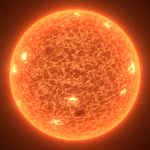 |
The lowest mass stars are commonly referred to as Red Dwarf stars. They are the most abundant class of star, but their luminosity is very low, making it very impractical to construct Dyson spheres or even Dyson swarms around them. |
| Class K star | 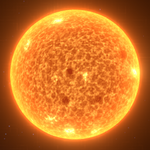 |
These low-mass stars typically have a luminosity of < 1 L☉, making them poor sites for construction of Dyson spheres. Dyson swarms may still be of some use, since they are much less resource-intensive. |
| Class G star | 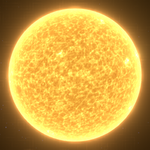 |
This class of star is the one that our Sun falls into. They typically have a luminosity of ~1 L☉. While they can make good use of Dyson spheres and Dyson swarms, higher-luminosity stars may be a more suitable location for Dyson sphere construction.
The starting system is always around a class G star. |
| Class F star | 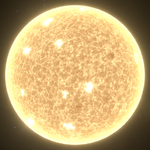 |
These stars have a higher luminosity than Class G stars but are around the same size. This makes them better sites for construction of Dyson spheres, if no Class A or higher stars are nearby. |
| Class A star | 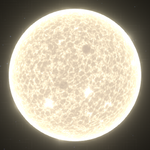 |
This class have fairly high luminosity, while not being particularly large. This makes them good sites for construction of Dyson spheres if materials are limited, or there are no nearby Class B or O stars. |
| Class B star | 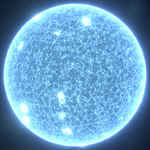 |
These stars have a high luminosity, while not being as large as Class O. This makes them excellent sites for construction of Dyson spheres if materials are more limited. |
| Class O star | 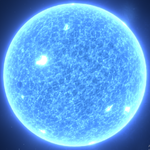 |
The brightest star type, ideal for constructing Dyson spheres around them. However, they also tend to be the largest, and so require more materials to do so. |
| Giant star | 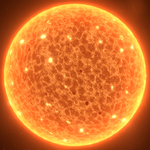 |
Giant stars are special stars that are basically larger versions of main sequence stars. Giants are generally >10R⊙ and have higher luminosity than their main sequence counterparts. Depending on their spectral class, they are referred to as Red, Yellow, White, or Blue Giants. M-class Red Giants and B-class Blue Giants are the most common giant stars in the universe, while Yellow and White Giants are extremely rare. |
| White Dwarf | 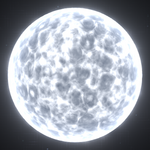 |
A stellar remnant left over after the death of a star that was not massive enough to form a neutron star or black hole, composed of electron-degenerate matter. Low luminosity makes them poor sites for construction of Dyson spheres. Dyson swarms may still be of some use, due to their considerably lower resource requirements.
Planets orbiting White Dwarves are guaranteed to have veins of Fractal Silicon, Kimberlite Ore, and Grating Crystal. |
| Neutron Star | 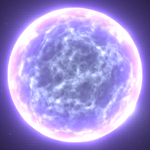 |
A stellar remnant following a supernova, composed of neutrons with a shell of electron-degenerate matter. Low luminosity makes them poor sites for construction of Dyson spheres. Dyson swarms may still be of some use with their much lower resource requirements.
Only a single Neutron Star generates per cluster. Due to their low temperature and luminosity, all planets orbiting a Neutron Star are frozen worlds. Neutron Star systems are one of the only places that Unipolar Magnets can be found. |
| Black Hole |  |
A massive stellar remnant following a supernova, it has been crushed into a point so dense and with such immense gravity that light itself bends around it and is sucked in. They are usually surrounded by an accretion disc. Their extremely low luminosity makes construction of Dyson spheres or Dyson swarms a vanity project, as they will produce little power.
Like Neutron Stars, only one Black Hole generates per cluster, and all planets orbiting Black Holes are frozen worlds. Black Hole systems are the only place outside of Neutron Star systems where Unipolar Magnets can be found. |
Sources of rare veins
| Commonly found on habitable planets (Oceanic Jungle, Pandora Swamp, Prairie, Red Stone, Sakura Ocean, Savanna planets). Also occurs on roughly every second Crystal Desert planet. | |
| Commonly found on Ice Field Gelisol, Frozen Tundra and Scarlet Ice Lake planets and Ice Giants. Also occurs on Ashen Gelisol and Barren Desert planets. Only rare resource aside from Crude Oil that can spawn in the starting system. | |
| Commonly found on habitable and oceanic planets (Mediterranean, Oceanic Jungle, Pandora Swamp, Prairie, Red Stone, Sakura Ocean, Savanna and Waterworld planets). Guaranteed to be found on the starting planet. | |
| Commonly and abundantly found on Waterworld planets. Also occurs in smaller quantities on habitable planets (Oceanic Jungle, Pandora Swamp, Prairie, Red Stone, Sakura Ocean and Savanna). | |
| Only found on Volcanic Ash planets. | |
| Commonly found on Frozen Tundra planets. Also occurs on Arid Desert, Barren Desert, Gobi, Hurricane Stone Forest, Lava and Scarlet Ice Lake planets and rarely on
Ashen Gelisol and Ice Field Gelisol planets. Guaranteed to spawn on planets orbiting White Dwarves. | |
| Commonly found on Pandora Swamp, Ice Field Gelisol, Ashen Gelisol, Hurricane Stone Forest, Gobi, and Lava planets. Also rarely found on Frozen Tundra planets and very rarely on Scarlet Ice Lake and Barren Desert planets. Guaranteed to spawn on planets orbiting White Dwarves. | |
| Only found on planets (Frozen Tundra and Ice Field Gelisol planets) orbiting Neutron Stars or Black Holes. | |
| Commonly found on Crystal Desert planets. Also occurs on Frozen Tundra, Hurricane Stone Forest, Scarlet Ice Lake and Ice Field Gelisol planets and rarely on Barren Desert, Lava, Rocky Salt Lake, Gobi and Ashen Gelisol planets. Guaranteed to spawn on planets orbiting White Dwarves. | |
| Only found on Gas Giants. |
State of stellar objects
Planets can have multiple physical attributes and states, which are listed below.
| Name | Description | Image |
|---|---|---|
| Tidal locking (TL) | Planets that has the same rotational period as orbital period, and consequently has one side permanently facing its host star or planet. Very useful to capture the host star's energy via solar panels and/or ray receivers | |
| Sattelite (SAT) | Astronomical objects that orbit another object that isn't a star, or in simpler terms, a moon. The starter planet is one example of such object. However, building EM-rail ejectors would be problematic, as the orbiting parent can block the sun, rendering them useless until the orbiting object passes, this decreases the time the EM-rail ejectors can fire sails, and decreases their effeciency. | |
| Reverse Rotation (RR) | The astronomical object in question rotates in the reverse direction, or clockwise when viewed from one of the poles. | |
| Horizontal Rotation (HR) | The planet has an axial inclination close to 90° causing it to rotate around a horizontal axis when viewed from the stellar poles. Still experiences seasons. | |
| Orbital Resonance (OR) | The planet has longer days. Orbital resonance 1:2 would mean a cycle of two days per year and 1:4 four days per year. Orbital resonance of 1:1 would be tidal locked. | |
| Plural Satellites (PS) | The gas giant has two planets orbiting it instead of one. The planets will sometimes be only 1000 meters away from each other. |
See also
Notes
- ↑ Formerly called "Mediterranean"
- ↑ Formerly called "Waterworld"
- ↑ Formerly called "Red stone"
- ↑ Formerly called "Hurricane Stone Forest"
- ↑ Jump up to: 5.0 5.1 5.2 5.3 Added in the Patch 0.7.18.6914
- ↑ Formerly called "Barren desert"
- ↑ Formerly called "Ashen gelisol"
- ↑ Formerly called "Ice field gelisol"
- ↑ Formerly called "Rocky Salt Lake"
- ↑ Formerly called "Frozen tundra"
- ↑ Jump up to: 11.0 11.1 11.2 11.3 Added in the Patch 0.9.26.12891
- ↑ Formerly called "Scarlet Ice Lake"
- ↑ Formerly called "Crystal desert"
- ↑ Formerly called "Prairie"
- ↑ Formerly called "Arid desert"
- ↑ Formerly called "Volcanic Ash"
- ↑ Formerly called "Oceanic jungle"

